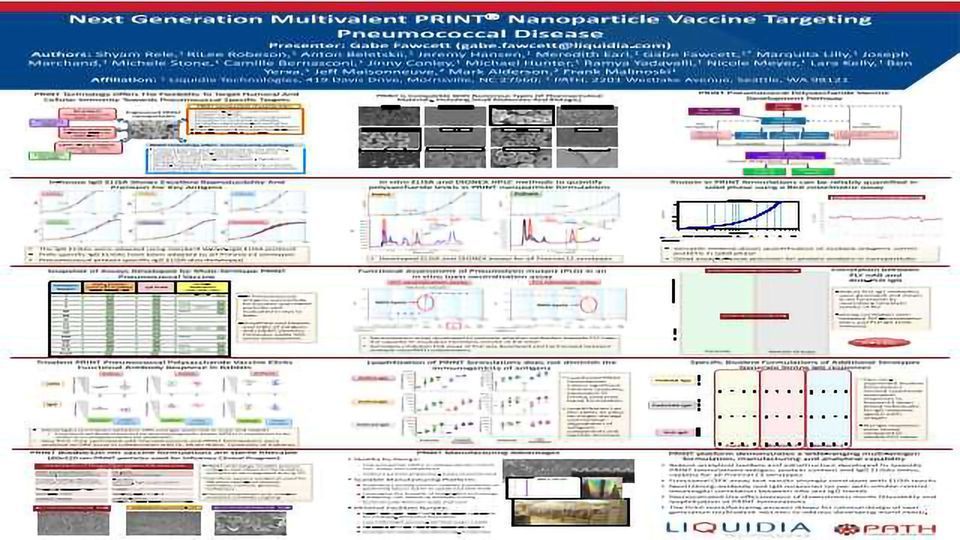Next Generation Multivalent PRINT Nanoparticle Vaccine Targeting Pneumococcal Disease

Background and Aims: A new generation PRINT nanoparticle Pneumococcal vaccine matrix has been designed to mimic size and structural aspects of bacterial pathogens to efficiently present and deliver polysaccharide and protein antigens to elicit robust immune responses. These compositions have been repeatedly characterized by physicochemical and bioanalytical assays to quantify polysaccharide and protein content. To imitate bacterial size, 80x320nm rods were used to formulate particle compositions consisting of CRM197 or mutant Pneumolysin protein (PLD) as a carrier protein/immunogen combined with purified Pneumococcal polysaccharides (PnPs) 1,5,6A,14 and 19A. All particle vaccines demonstrated strong immune responses in BALB/c mice.
Methods: In vitro antibody-based ELISA, DIONEX and BCA assays have been developed and optimized to quantify the amount of polysaccharide and protein in PRINT nanoparticles. Antigen-specific IgG (for 5 PnPs strains, and PLD) and cellular assays (IL-17, IFN-γ) have been developed to quantitate the immune response in mice. PRINT particles were manufactured using roll-to-roll PRINT manufacturing process and were purified by Tangential Flow Filtration (TFF). Using the TFF process, PRINT suspensions afforded stable nanoparticle formulations with average particle size of ~250 nm and >70% post TFF recovery yield. The particles were further characterized using SEM, DLS, Zeta Potential, sterility, pH, Osmolarity.
Results: Five of the Prevnar 13 serotypes have been successfully formulated and quantified in PRINT particles with strong reproducibility. Antigen-specific IgG responses were observed for all five serotypes and were found to be ≥ Prevnar 13. This response driven by particulated delivery of PnPs was independent of adjuvant components. The level (IgG) and quality (neutralizing) of antibody responses produced by particulated delivery of PLD protein demonstrated superiority as compared to soluble antigen and equivalent to soluble antigen plus adjuvent. These findings demonstrate the ability of PLD not only to serve as an alternative carrier protein to CRM197 but also act as an effective immunogen in PRINT formulations.
Conclusions: Incorporation of five of the most prevalent Pneumococcal Polysaccharides and multiple proteins as carriers in PRINT nanoparticles has demonstrated a wide-ranging multi-antigenic formulation that could allow for broadened efficacy and be adaptable to different regions through incorporation of relevant serotypes.
Methods: In vitro antibody-based ELISA, DIONEX and BCA assays have been developed and optimized to quantify the amount of polysaccharide and protein in PRINT nanoparticles. Antigen-specific IgG (for 5 PnPs strains, and PLD) and cellular assays (IL-17, IFN-γ) have been developed to quantitate the immune response in mice. PRINT particles were manufactured using roll-to-roll PRINT manufacturing process and were purified by Tangential Flow Filtration (TFF). Using the TFF process, PRINT suspensions afforded stable nanoparticle formulations with average particle size of ~250 nm and >70% post TFF recovery yield. The particles were further characterized using SEM, DLS, Zeta Potential, sterility, pH, Osmolarity.
Results: Five of the Prevnar 13 serotypes have been successfully formulated and quantified in PRINT particles with strong reproducibility. Antigen-specific IgG responses were observed for all five serotypes and were found to be ≥ Prevnar 13. This response driven by particulated delivery of PnPs was independent of adjuvant components. The level (IgG) and quality (neutralizing) of antibody responses produced by particulated delivery of PLD protein demonstrated superiority as compared to soluble antigen and equivalent to soluble antigen plus adjuvent. These findings demonstrate the ability of PLD not only to serve as an alternative carrier protein to CRM197 but also act as an effective immunogen in PRINT formulations.
Conclusions: Incorporation of five of the most prevalent Pneumococcal Polysaccharides and multiple proteins as carriers in PRINT nanoparticles has demonstrated a wide-ranging multi-antigenic formulation that could allow for broadened efficacy and be adaptable to different regions through incorporation of relevant serotypes.




